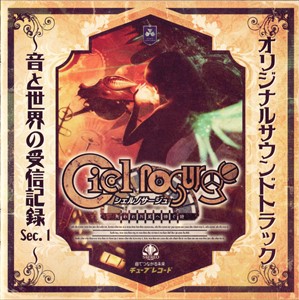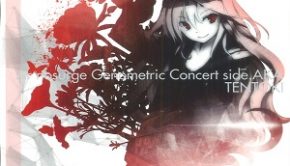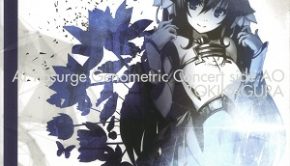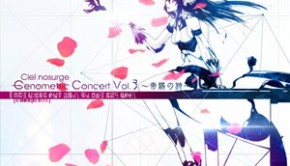Surge Concerto: Ciel nosurge Original Soundtrack -Sound and World Reception Record- Sec. 1
 |
Album Title: Ciel nosurge Original Soundtrack -Sound and World Reception Record- Sec. 1 |
| Record Label: Gust |
|
| Catalog No.: FFCT-0027 |
|
| Release Date: February 27, 2013 |
|
| Purchase: Buy at CDJapan |
Overview
The Ciel nosurge Original Soundtrack -Sound and World Reception Record Sec. 1- album is the first part of the two expected so far for the collection of music for Gust Inc.’s simulation/visual novel hybrid Ciel nosurge ~A Song Offered to the Lost Planet~. Given its status as a prequel to the Ar tonelico series, it is to be expected that it would offer high quality compositions and arrangements similar in style to it in addition to the vocal songs covered in the Genometric Concert albums. However, does the music contained in this album hold a candle against its predecessors? Does it fit the universe and represent it properly through its sounds?
Body
Once again, I’d like to recommend first giving a read to the review for the Ciel nosurge Genometric Concert Vol. 1 –Pact Songs- in order to have a good introduction to the universe of the game in order to better understand some of the terms and situations I will be referring to during my analysis of this album.
The soundtrack is generally a mix of electronica, synthesizer and industrial/mechanical sounds alongside with a more organic instrumentation composed of piano, guitars and violin, as well as featuring several tracks that make use of Akiko Shikata’s vocal talents as insert choruses. While the album itself doesn’t offer a composer breakdown, most of it was also made available as an in-game jukebox with composer comments that allow the players and listeners to know who composed which song. Thanks to this, it’s known that Akiko Shikata, aside of being one of the main vocalists for the Genometric Concerts songs as well as composing and arranging several of the songs in there, is also the sound director for the game and the main composer of the instrumental music. She is joined by Yu Shimoda, whose compositions were unfortunately not featured in this album, and a newcomer that goes by the rather lengthy alias SSS-Solid State Signal-OOPS TEAM WEEDS. Kohta Takahashi has used SolidState as an alias in the past, but I’m not sure if this is him.
An excellent example of what could be expected from this album is its first track: “GATE::49.212.40.208”. It is entirely composed through synthesizer and electronic sounds, and is used in the configuration and DLC installation screen in-game, as well as during a segment in which Ion’s knowledge about the Cielnotrons is being tested. Curiously enough, the name is also a real-world IP address that leads to Gust’s genomirai.com website, which is a promotional page for Ciel nosurge that at the time of writing of this review, allows visitors to play a short choose-your-own-adventure text game that serves as an interquel between Ciel nosurge and its sequel Ar nosurge.
For examples on how Shikata’s talent vocals work in the music, we have the tracks “Introductory Resonance”, “Lament” and “ExecuTron”. The first one starts with elevator sounds which get joined later on by Shikata singing the initial choruses of the game’s opening theme, “To the Songless Hill”, though with an entirely different melody and tone, sounding more reminiscent of a prayer, which is heard during the introductory segments in the game showcasing Ion’s nervousness before the perspective of having to talk in front of a large crowd and her disastrous first public appearance. “ExecuTron”, it’s a more technologically oriented piece formed by synthesizer, electronic percussions and Shikata’s choruses, which is usually played during the scenes in which the characters are interacting with pieces of technology like the Cielnotrons, G2Trons and the Neptron in the fourth chapter. “Lament” can only be described as a funeral dirge, which begins with some choruses that sound similar to moans accompanied by soft bells, until the song shows its true form: several choruses actually singing out in a sad tone and accompanied by sorrowful strings, harp and metal percussions. This one is played during tragic scenes; the first section captures Tabou and Ion desperate search for a lost character, whereas the second section resolves the character’s tragic fate.
Going to more organic-sounding pieces, we have “Flower of Dusk”, which is pretty much the main theme of Chapter 3 and the song representing the Planetary Maison Colon which Ion and Nay arrive to in said chapter. It’s a beautiful and slow piece formed by soft metal percussions, Shikata’s singing, and later on, by strings and a flute. It reflects the nature of the Colon being the only place in Ra Ciela where it is possible to see a starry sky, albeit faked, after its sun became a red giant. “Dwelling of Dreams” can be heard playing during the Trials Arc in the Dive Gate, which is is the place where the player Dives into Ion to try to fix her broken memories. It is an energetic piece played by a guitar, bass, strings and Shikata’s choruses singing once again the initial choruses from “To the Songless Hill”. It is very uplifting, and it pretty much feels like as if the game was beckoning the player to another world with it. I have to mention that the choruses employed here are a bit different from the game version: in some parts they are stronger than in the game, and the final reprise of the choruses is absent in the soundtrack, having only the instrumental part on its place.
And finishing with the pieces featuring choruses, we have “Flask Sea”, which is lengthy enough to be considered a full-length song on its own right. It is formed by playful, child-like vocals sung by Shikata herself, which are combined with her more mature-sounding voice, with a background of violin, flute and guitar. This very playful and cheerful piece is used in-game as the music for the Sharl Nest, which is where the player scans barcodes with the PlayStation Vita’s camera to create new Sharls (fairies), and these in turn can be used to restore the destroyed areas of Ion’s memory. This is essential to progress, as watching the chapters in Ion’s Genometrics or Dream World is impossible if the memories haven’t been restored first. Additionally, while here the song is expanded and ends in a fade-out, in game the finale is a duet composed of the xylophone-like and synth parts playing together to then loop back to the beginning.
However, while the other tracks don’t feature proper choruses or singing, that fact doesn’t make them any less enjoyable: we also have the two sister tracks “Promise ~A Small Encounter~” and “Promise ~An Unforgettable Dream~”. While both songs share the same beautiful yet sad melody, they have different arrangements: “A Small Encounter” has somewhat of an ancient and mystical feeling with its wind sounds and metallic percussions, as well as its acoustic leads. This song is heard during Ion’s first encounter with Tabou at the very beginning of the game. On the other hand, “An Unforgettable Dream” is generally heard during the parts Ion wrestles with the idea of being an Empress candidate, and has a more introspective arrangement formed by guitar, piano and violin.
We also get an instrumental arrangement of the vocal piece “Ahih rei-yah” in this album. In this case, the song is titled “Ahih rei-yah ~Connected Feelings~”. While the original song was rather slow in rhythm and had a strongly classical-Japanese instrumentation, this version has a faster rhythm and a livelier instrumentation composed of electric guitar, flute, piano and violin. It is definitively a much more cheerful and vibrant version of the song, and one that is supposed to be greatly uplifting for the listener. This song plays during the preparations Ion and her friends are making for her to sing “Ahih rei-yah” proper to save the city of Manjusara by asking everyone to lend them their Cielnotrons, as well as during the aftermath of Ion having sung that song.
Now moving to more ethnic-styled pieces, we have “Signpost of Beginning” and “Manjusara”. While they both don’t share a common melody, the common thread they both have is that they have a distinct Chinese flavor to both of them, which is due to the city of Manjusara having so many elements from both the Japanese and Chinese cultures present on its architecture, as well as on its overall atmosphere. While “Signpost of Beginning” has a much more slow rhythm and has a rather sad feeling, “Manjusara” has a much more fast-paced rhythm and is quite a cheery piece. As it should be obvious, “Manjusara” plays in the segments taking place in its namesake city, while “Signpost of Beginning” can be heard in the map screen for Chapter 1. There is also “Cold and Dignified”, which is the theme for Kanon and thus is heard in some of the scenes where she is featured. It has a very similar instrumentation to “Manjusara” and also has a strong Chinese flavor to it, though it also has a more overbearing feeling to it due to making use of orchestration.
And closing off the Shikata side, we have “Genometrics” and “Shards of Loss” that mix both electronic and organic elements. “Shards of Loss” begins with some synthesizer and electronic sounds, but then it turns into a heartbreaking violin piece. It is usually heard prior to very sad scenes or one where the characters are feeling a great anxiety and distress. As for “Genometrics”, it has a similar instrumentation but gives more of a mysterious and dreamy feeling than of a sad one, and this song is heard in the GustID registration and login screens, as well as during the parts in which the characters are Diving into the mind (Genometrics) of someone.
SOLID STATE SIGNAL also contributed some nice pieces, though their quality is somewhat lacking in comparison to Shikata’s because they only use samplers for the instrumentation. An example of this would be the themes for both of the main factions in the storyline: “Imperial Genometrics Synchronization Mediation Institute” and “Imperial Astronomical Quantum Wave Theory Laboratory”. The former is a relaxing piece led by synth piano and piano, though it is quite flowing and doesn’t feel like it has a proper resolution. On the other hand, the latter has a slightly faster rhythm that makes use of synth orchestra and electronic effects, and I find it more enjoyable to listen due to its changes in tone and how it builds up towards its ending. There are similar pieces like “Cosmic City”, and “Stargaze ~Galaxy Flight~”. The former is an uplifting, rhythmical piece that gives off the feeling of being in a city in space, Dream Sphere Colon. As for “Stargaze ~Galaxy Flight~”, the piece has a very nice second segment composed of strings, harp and electronic sounds, but it’s quite short and it takes quite long to get there, with the first part being rather repetitive.
SOLID STATE SIGNAL also was in charge of the more funny and comical themes used in the soundtrack, such “Let’s Join Our Hands!” and “A Couple’s Photograph”. The former is a medium-paced piece that makes use of various kinds of synth and distortion effects, even using one at one point that sounds like a chiptune, for comical effect. On the other hand, the latter is slower, though it is more of a typical funny piece used for whenever a character does something foolish. However, I also have to say that it surprises a bit with a segment in which some strings come in at the middle of the song, before it reverts into being funny again.
And while there isn’t still official confirmation that SOLID STATE SIGNAL composed “Crisis” and “Run Through!”, I have a very strong suspicion of him doing so due to the instrumentation used. The first one plays at the point in which the people are scrambling to escape from the Wave Burst that will hit Manjusara during the first chapter, and it’s made from an extremely disharmonic combination of synthesizers that then give away to a very upsetting melody, which really convey to the listener that the situation is critical. As for the second, it is a frantic piece made of a synth orchestra, choir and snare drum, and I have to say that despite it being a piece reserved for dangerous moments in which the characters are trying to rescue someone or try to get alive from a collapsing place, it’s quite enjoyable. Actually, I could even say that this piece gives off a very similar atmosphere to several of the compositions Michiru Yamane made for the Castlevania series.
SOLID STATE SIGNAL also contributed one of the more emotional and sensitive pieces of the soundtrack: “A Small Flower”. This is used in several emotional scenes in the game, one of them being Casty deciding to escape from her house after her father grounded her to go help Tabou. It begins with some synth sounds and a piano, but it soon blossoms into quite a beautiful and delicate piano melody. And while the composer for “Sunset Avenue” is unknown right now, I have to say that both pieces are similar enough to be considered as made by the same person: both make use of a very similar instrumentation, though I feel “Sunset Avenue” is more developed and takes across much more warmth thanks to the addition of the violin near the reprise of the initial melody.
Finally, the album ends with a bonus track courtesy of Akiko Shikata called “The Boy Traveling Through the Glittering Desert”. Though the track thematically has nothing in common with the rest of the soundtrack, it is quite an enjoyable Arabic-inspired piece similar to other works Shikata has made in her own albums previously, and according to her, it is supposed to evoke the travel theme of the game: the three years of trials Ion has to endure to become Empress, and the journey she makes alongside the player in order to regain her lost memories.
Summary
This soundtrack was pretty much the return to form of the Ar tonelico-styled soundtracks after two years of absence and the rather disappointing soundtrack that was made for Ar tonelico Qoga: Knell of Ar Ciel. Both Akiko Shikata and SOLID STATE SIGNAL managed to make a superb work of music that combines the electronic, organic and choral elements into an eclectic yet cohesive soundtrack that continues the sound of the Ar tonelico series as well as introducing several elements of its own. It is a bit sad that it doesn’t include some of the pieces featured in the game (such as the music box version of Promise), but as this is the first volume, I’m confident that they will be included in the second volume alongside the new pieces introduced from the fifth Ciel norsurge chapter onwards, once it gets released. I recommend it to all fans of Ar tonelico and Akiko Shikata, and anyone that has a like for choral and ethnic music, as well as some electronica, should find it to be to their liking too.
Do you agree with the review and score? Let us know in the comments below!
4.5
Posted on April 30, 2014 by Gerardo Iuliani. Last modified on January 19, 2016.














